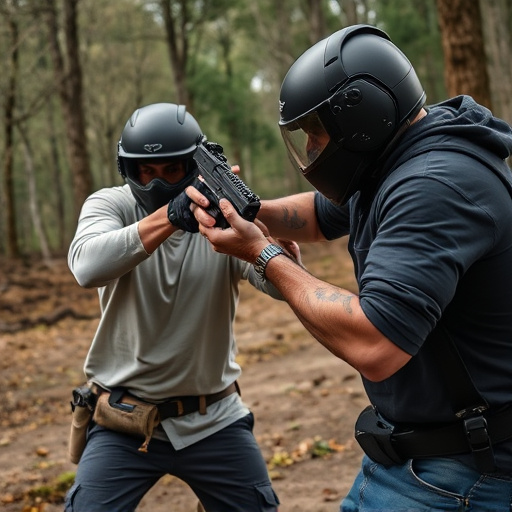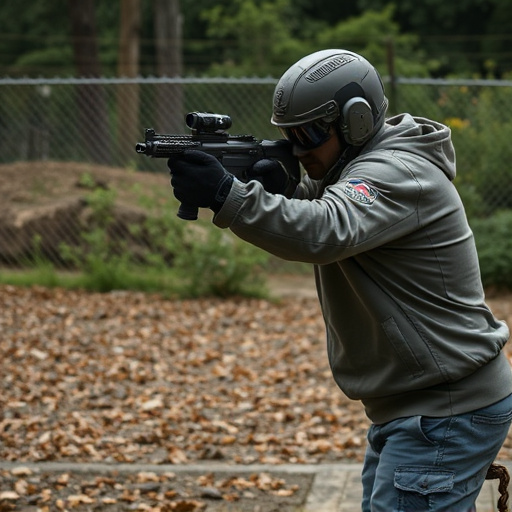Compact stun guns with built-in chargers offer a convenient, portable self-defense option, featuring high-voltage electrical pulses to temporarily paralyze assailants. Unlike Tasers that fire probes to disrupt nerve signals, these stun guns deliver intense but brief discharges causing pain and disorientation. Before acquiring one, understand local regulations, their range, activation mechanisms, potential side effects, and proper storage for responsible handling and safe disposal.
In the world of personal safety devices, Tasers and stun guns often cause confusion due to their similar purpose. This article provides a comprehensive overview of both, helping you understand their unique features. We’ll explore Understanding Tasers: A Comprehensive Overview, delve into Stun Guns: The Basics and Their Functionality, and highlight the benefits of Compact Stun Guns with Built-in Chargers. Through a detailed Comparison, we analyze performance and effectiveness, and discuss Legal Considerations and Safety Precautions for both.
- Understanding Tasers: A Comprehensive Overview
- Stun Guns: The Basics and Their Functionality
- Compact Stun Guns with Built-in Chargers: Features and Benefits
- Comparison: Taser vs Stun Gun Performance and Effectiveness
- Legal Considerations and Safety Precautions for Both Devices
Understanding Tasers: A Comprehensive Overview

Tasers, officially known as Conducted Electrical Weapons (CEWs), are less lethal force tools designed to incapacitate individuals through muscle contraction and disruption of nerve signals. They fire two small probes connected to thin wires, delivering a powerful electrical current that temporarily paralyses the target, allowing for safe restraint or control of aggressive individuals. Tasers have evolved from their initial use by law enforcement to include compact stun guns with built-in chargers, making them easily accessible and portable for personal defense.
The technology behind Tasers involves the use of high-voltage, low-current electrical pulses, which are safer than traditional stun guns that rely solely on high voltage. These pulses disrupt the body’s natural electrical signals, causing muscles to contract uncontrollably. This muscle spasm leads to temporary loss of balance and coordination, providing a brief window for officers or individuals to secure or subdue an aggressor. With their non-lethal nature and increasing availability in compact, easy-to-use forms like stun guns with integrated chargers, Tasers offer a valuable tool for self-defense and law enforcement operations alike.
Stun Guns: The Basics and Their Functionality

Stun guns, also known as electroshock weapons, are non-lethal self-defense devices designed to temporarily incapacitate a target through electrical current disruption. They operate on the principle of delivering high voltage, low amperage electric pulses to the body, specifically focusing on nerve impulses and muscle control. This results in a powerful jolt that can cause the target to experience muscular spasms, disorientation, and temporary paralysis, making it an effective tool for self-defense against assailants.
One popular variant of stun guns is the compact stun gun with built-in charger. These devices are engineered to be easily portable and user-friendly. Their compact design allows them to fit comfortably in a pocket or purse, ensuring they’re always within reach when needed. The built-in charger eliminates the need for additional accessories, simplifying their use and maintenance. This type of stun gun is particularly appealing to individuals seeking a discreet yet powerful self-defense solution that can be easily carried and accessed in emergencies.
Compact Stun Guns with Built-in Chargers: Features and Benefits

Compact stun guns with built-in chargers offer a convenient and efficient self-defense solution for those seeking a discreet yet powerful device. One of the key features is their size; these stun guns are designed to fit comfortably in your hand or easily hide away, making them an ideal option for personal protection without drawing excessive attention. The integrated charger eliminates the need for separate charging devices, simplifying maintenance and ensuring you’re always ready to use it when needed.
These compact weapons boast high voltage and powerful electrical currents, capable of incapacitating an assailant while allowing users to maintain their distance. The built-in charger typically utilizes USB or battery power, making recharging effortless. This feature is particularly beneficial for frequent users who require a reliable device without the hassle of constant replacements or separate charging accessories.
Comparison: Taser vs Stun Gun Performance and Effectiveness

When comparing a Taser and a stun gun, understanding their performance and effectiveness is crucial for making an informed decision, especially when considering a compact stun gun with built-in charger as a personal defense tool. While both devices utilize electric current to temporarily incapacitate a target, they differ significantly in their operation and impact.
A Taser, officially known as a Conductivity Energy Device (CED), fires two small probes connected to thin wires, delivering a high-voltage, low-current electrical pulse. This pulse disrupts the nervous system, causing muscle spasms and temporary paralysis. In contrast, a stun gun produces a direct electric current that flows between two electrodes, causing pain and disorientation through intense but short-lived electrical discharge. The compact stun guns with built-in chargers offer convenience and portability, making them accessible for personal protection in various situations. However, the effectiveness of both lies not only in their ability to stop an assailant but also in factors such as range, power output, and the level of discomfort they inflict.
Legal Considerations and Safety Precautions for Both Devices

Both Tasers and stun guns are designed for personal protection, but they operate under distinct legal frameworks and safety guidelines. It’s crucial to understand the specific regulations in your area before considering either device, as misuse can lead to severe legal repercussions. For instance, some regions prohibit the civilian possession of Tasers, while stun guns may be allowed with certain restrictions. Additionally, the use of both devices against law enforcement officers or in certain high-risk situations is regulated and may require special training and certification.
When it comes to safety precautions, handling either device requires responsibility and caution. For users considering a compact stun gun with built-in charger, understanding the range, activation mechanisms, and potential side effects like muscle spasms or temporary paralysis is vital. Regular maintenance and ensuring proper storage are also essential to guarantee their reliability when needed. Similarly, Tasers require safe disposal methods as they contain high-voltage components, preventing them from falling into inappropriate hands.
In comparing tasers and stun guns, each device offers unique advantages. Tasers excel in incapacitating targets at a distance and are favored by law enforcement for their reliability. Stun guns, on the other hand, provide close-range protection with immediate impact. Among the available options, compact stun guns with built-in chargers stand out due to their convenience, portability, and ease of use. For personal safety, understanding legal considerations and adhering to safety precautions is paramount when carrying either device.
